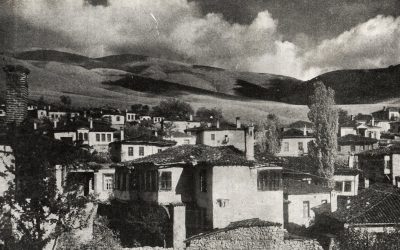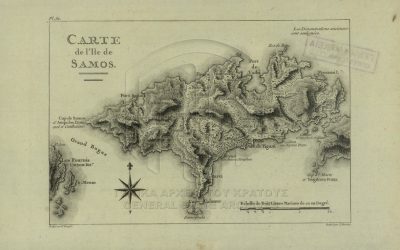In the mountains of Arcadia, 54 km southwest of Tripoli, lies the picturesque village of Karytaina. An administrative and cultural center during the Ottoman period boasting over 3,000 inhabitants, it became the principal village in Gortynia in modern times. The famed 1821 Revolution hero, Theodoros Kolokotronis, and many contemporary government officials have roots in the village. It is also the birthplace of Antonis, the father of John Nicolopoulos, late ex-husband of Mary LaViolette, and of Antonis’ first cousin Constantine Palamidis, grandfather of Dena Palamedes.
Mary and Dena met in 2022 when DNA testing revealed a match between Dena and John. “I wrote the first email to connect us,” Mary related. “When John received his DNA test results, Dena was his closest match. It was a jackpot!” Their common ancestor was Dimitrios Konstantinou Nikolopoulos (1800-1860) who was John’s great-grandfather and Dena’s 2nd great grandfather.

Dena and Mary had each begun exploring their roots many years earlier. Mary created her first family tree when she was seven years old, documenting her grandmother’s family from Andros and her grandfather’s family from Crete. After she married John Nicolopoulos and went to his paternal village for the first time, Mary fell in love with Karytaina. “Then we visited again in May 1976,” she recalled, “and I stayed there in June and July to assist John’s first cousin, Eleni Matsika Spyrakopoulou, hand copy the church records which begin in 1885 and photocopy the community census records (Dimotologion) of Karytaina. We began creating trees, family by family, and also taped oral interviews of older residents.”
Dena was 12 when her mother died, and she spent the next summer with her grandparents. “My grandmother had a drawer of photographs, and when I was bored, I would ask her questions about them, which led to questions about the family tree.” Dena recalled. “I asked her to help me write a template letter, which I sent to all her siblings along with a self-addressed stamped envelope. They replied!” That correspondence gave Dena the resources to start her Scottish-Canadian mother’s tree. At age 16, Dena traveled to Scotland where she met some of her mother’s relatives. Over the years, she kept all her notes, but it was not until 2012, when her aunt suggested she start a tree on Ancestry, that Dena began to correlate that information. Dena’s work on her Greek side began in 2013 as a way to engage her housebound 96 year-old father, George. In 2014, she went to the first Greek genealogy conference held in New York City. When Georgia Stryker Keilman translated the 1865 Election Registries of Karytaina ((Part 1) & (Part 2), George was able to recall many more family members by examining the names on the 1865 voters’ list (details in this post).

In 2010 John retired in Athens and in May 2020 Mary returned from the U.S. and retired in Karytaina. Mary joined Hellenic Genealogy Geek in February 2021 where she learned of and joined Greek Ancestry’s Village History Project. In September 2021, after the DNA testing, Mary used Ancestry.com to build John’s tree. Knowing from her previous research with the records that everyone in Karytaina is a cousin– or a cousin of a cousin–to every other person, she renamed John’s tree the “Karytaina Village Project” and through oral interviews, especially with Dina Chronopoulou Palyvou-Ksourafa, she worked on expanding the tree. “John was second cousin to Dena Palamedes’ father, so I added the Palamedes family,” Mary related. “After a few conversations with Dena, I realized she was well versed in genealogical research and its technology, so I asked her to collaborate with me on the project.
“First, we added the Freedom Fighters, which were listed in the book, Φευγάτες Εποχές by John Antonopoulos (a prolific Karytaina author). In 1821, the Freedom Fighters would have been born around the 1790s and we knew these were from the original families. Next, we began the strategy of making a ‘skeleton’ tree of the males for each surname branch by using the census records: the Election Registries of 1865 and 1873 (only men voted then) and the Mitroo Arrenon (male births for military purposes) which starts in 1843. As the skeleton tree takes form, we continue looking for a particular surname in the death records, which give the age, so we can approximate the birth year. Thus we can go back to births even before 1800 for some elderly men and women. We also use the 1914 census of families as well as birth and marriage records to populate each tree. By adding the females, the surname tree branches become intertwined and the village tree forms.”
Much of the initial information which Mary and Dena worked with came from oral histories that each had collected. As they discover new connections in the various records, they add them to the tree. They have learned that even if names are initially unconnected, connections are eventually made as additional data is found. They work on one surname at a time—starting with the male, then looking through records to find his wife and children. The church records are critical to creating the families as are the 1914 Dimotologion family census records.
In February 2023, one year after John’s death, as Mary helped to prepare the contents of his home office for donation to the Gennadion Library, she came across six boxes of Karytaina archives which she had been seeking. Four of these boxes contained notarial records and indexes John had salvaged before 1976 from the dilapidated notary building in Karytaina used by several generations of Nikolopoulos notaries. The two other boxes h the records that Eleni and Mary had copied in 1976 and given to John for safekeeping: birth/baptism, marriage, and death records from the church; and from the Community, a limited number of additional marriage and death records, Mitroo Arrenon and the Dimotologion family census from 1914 which lists all family members.

There are two versions of the 1914 Mitroo Arrenon: one for Karytaina only; the second for Karytaina and its surrounding villages. The Dimotologion family census now found in the Megalopolis City Hall was created in 1964 and the office does not have the one from 1914. They also discovered that local historian, Scobie Kostopoulos in his book, Karytaina Volume A, had transcribed a 1907 version that has since been destroyed in a flood. Little did Mary and Eleni know that their work in 1976 would result in the preservation of so many of these old records.
The boxes of notarial records and documents have now been digitized by Gregory Kontos’ team at Greek Ancestry and are– or will soon be–available on the Greek Ancestry website. The data from these records will eventually be incorporated into the Karytaina tree.
The earliest of the records begin in 1884 and are handwritten transcriptions of the estimated 4,000 original church birth, marriage and death entries. “We are fortunate, this work was done before the introduction of privacy legislation and the European General Data Protection (GDRP) regulations,” Dena said, “and Eleni and Mary were able to record entries, in some cases up to 1980. Now, because of GDRP only information regarding deceased individuals can be made accessible.”
In March 2023, Dena joined Mary in Athens and Karytaina for six and a half weeks. Their shared objective was to collect and digitize as much of Karytaina’s genealogical relevant information as possible.
During the first four weeks Dena took Greek language training, and in the evenings and on the weekends they began to scan the Karytaina records using Greek Ancestry’s professional scanner. Following the training, they spent a week exploring the resources available in the City of Athens, including the Hellenic National Library, the University of Athens archives, the Stamiris Collection for Stemnitsa (Ypsous) Collection held by the National Bank of Greece and the Hellenic Library of Parliament.

After the primary collections in Athens were exhausted, they turned their attention to records held in Karytaina, Megalopolis and Andritsaina. Karytaina is now part of the municipal area of Megalopolis so the Mitroo Arrenon and Dimotologion family census are now held at the Megalopolis City Hall. Andritsaina is where many of their Karytaina ancestors went to high school. The village is home to the Public Historical Library of Andritsana, also known as the “Nikolopoulos Library,” which houses one of the rarest collections of old books and manuscripts of Franks, Venetians and chieftains of the Greek Revolution which were donated by Konstantinos Agathofronas Nikolopoulos.
Mary and Dena have created an English speaking Karytaina Ancestry Facebook Page, intended to connect the Karytaina diaspora. Their work on the Karytaina project will eventually be made available on a website. In addition to the Karytaina tree, Mary and Dena would like to incorporate historical photos including those gathered by the Karytaina Association of Athens and displayed in Karytaina the summer of 2023 at the former home of Nikolaos Petrou Dimitraklopoulos 1864-1921, author of modern Greek law.
The 1976 tapes of interviews conducted by Eleni and Mary, including one of a 107-year-old woman, are being converted to mp3 and will eventually be uploaded to the website. Mary is gathering histories of the houses, buildings, and the 41 churches in the village which will be displayed on the website with photos and references to Google Earth maps so descendants can see where their ancestors lived.
Mary and Dena hope that their initial efforts will encourage those with Karytaina ancestry to contribute their research, photos and DNA discoveries to the shared tree. Each piece of Karytaina history others can gather will make the task easier of building the Karytaina village tree. Contact Mary and Dena at: KarytainaAncestry@gmail.com
About the Author
Carol Kostakos Petranek is a Greek genealogy expert, associate of Greek Ancestry and blogger at SpartanRoots.com.



